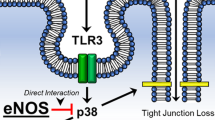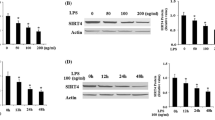Abstract
Background
Nitric oxide (NO) has frequently been shown to inhibit leukocyte adherence to activated endothelium thus displaying anti-adhesive and immunosuppressive activities. A molecular mechanism contributing to this effect is described.
Materials and Methods
Primary murine aortic endothelial cells were activated with interleukin (IL)-1β to express intercellular adhesion molecule-1 (ICAM-1) mRNA in the presence or absence of the physiological spontaneous NO-donor S-nitrosocysteine. Subsequently, semiquantitative RT-PCR and gel shift assays with nuclear extracts were performed to analyse the effects of NO on ICAM-1 mRNA expression and on the activity of transcription factors involved in ICAM-1 transcription. In addition, luciferase reporter gene activity of cytokine-activated cells transiently transfected with an ICAM-1 promoter-luciferase construct and cultured in the presence of the slow-releasing NO-donor DETA/NO was determined.
Results
NO at subtoxic concentrations decreases IL-1β-induced endothelial ICAM-1 mRNA expression. This inhibition occurs at the transcriptional level, as NO affects IL-1β-induced ICAM-1 promoter activity in transiently transfected cells. Using gel-shift assays and double-stranded oligonucleotide consensus sequences of the known transcription factor binding sites of the ICAM-1 promoter, Sp1 and AP-1 were identified as transcriptional activators of IL-1β-driven ICAM-1 expression. The DNA binding of both of these transcription factors to specific binding sites of the ICAM-1 promoter was decreased in MAEC exposed to NO.
Conclusions
Our studies indicate that the anti-adhesive effect of NO concentrations equivalent to high-output NO synthesis is mediated, at least in part, by inhibition of ICAM-1 expression via a concerted action of NO on the redox-sensitive transcriptional activators Sp1 and AP-1. This molecular mechanism may contribute to the anti-inflammatory actions of NO synthesized by the inducible NO synthase.





Similar content being viewed by others
References
Butcher EC. (1991) Leukocyte-endothelial cell recognition: three (or more) steps to specificity and diversity. Cell 67: 1033–1036.
Springer TA. (1994) Traffic signals of lymphocyte recirculation and leukocyte emigration: the multistep paradigm. Cell 76: 301–314.
Kubes P, Suzuki M, Granger DN. (1991) Nitric oxide: an endogenous modulator of leukocyte adhesion. Proc. Natl. Acad. Sci. USA 88: 4651–655.
Kröncke KD, Suschek CV, Kolb-Bachofen V. (2000) Implications of inducible nitric oxide synthase expression and enzyme activity. Antiox. Redox Signal. 2: 585–605.
Peng HB, Spiecker M, Liao JK. (1998) Inducible nitric oxide: an autoregulatory feedback inhibitor of vascular inflammation. J. Immunol. 161: 1970–1976.
Binion DG, Fu S, Ramanujam KS, et al. (1998) iNOS expression in human intestinal microvascular endothelial cells inhibits leukocyte adhesion. Am. J. Physiol. 275: G592–G603.
Kubes P, Sihota E, Hickey MJ. (1997) Endogenous but not exogenous nitric oxide decreases TNF-α-induced leukocyte rolling. Am. J. Physiol. 273: G628–G635.
Hickey MJ, Sharkey KA, Sihota EG, et al. (1997) Inducible nitric oxide synthase-deficient mice have enhanced leukocyte-endothelium interactions in endotoximia. FASEB J. 11: 955–964.
Hickey MJ. (2001) Role of inducible nitric oxide synthase in the regulation of leukocyte recruitment. Clin. Sci. 100: 1–12.
Takahashi M, Ikeda U, Masuyama JI, et al. (1996) Nitric oxide attenuates adhesion molecule expression in human endothelial cells. Cytokine 8: 817–821.
Khan BV, Harrison DG, Olbrych MT, et al. (1996) Nitric oxide regulates vascular cell adhesion molecule 1 gene expression and redox-sensitive transcriptional events in human vascular endothelial cells. Proc. Natl. Acad. Sci. USA 93: 9114–9119.
Shin WS, Hong YH, Peng HB, et al. (1996) Nitric oxide attenuates vascular smooth muscle cell activation by interferon-γ. The role of constitutive NF-κB activity. J. Biol. Chem. 271: 11317–11324.
Spiecker M, Darius H, Kaboth K, et al. (1998) Differential regulation of endothelial cell adhesion molecule expression by nitric oxide donors and antioxidants. J. Leukoc. Biol. 63: 732–739.
Lindemann S, Sharafi M, Spiecker M, et al. (2000) NO reduces PMN adhesion to human vascular endothelial cells due to down regulation of ICAM-1 mRNA and surface expression. Thromb. Res. 97: 113–123.
Ballantyne CM, Sligh JE, Dai XY, Beaudet AL. (1992) Characterization of the murine ICAM-1 gene. Genomics 14: 1076–1080.
Maltzman JS, Carman JA, Monroe JG. (1996) Transcriptional regulation of the Icam-1gene in antigen receptor- and phorbol ester-stimulated B lymphocytes: role for transcription factor EGR1. J. Exp. Med. 183: 1747–1759.
Kroncke KD, Kolb-Bachofen V. (1996) Methods for the detection of nitric oxide interaction with zinc finger proteins. Meth. Enzymol. 269: 279–284.
Hrabie JA, Klose JR, Wink DA, Keefer LK. (1993) New nitric oxide-releasing zwitterions derived from polyamines. J. Org. Chem. 58: 1472–1476.
Suschek C, Rothe H, Fehsel K, Enczmann J, Kolb-Bachofen V. (1993) Induction of a macrophage-like nitric oxide synthase in cultured rat aortic endothelial cells; Il-1β-mediated induction regulated by tumor necrosis factor-α and IFN-γ. J. Immunol. 151: 3283–3291.
Chomczynski P, Sacchi N. (1987) Single-step method of RNA isolation by acid guanidinium thiocyanate-phenol-chloroform extraction. Anal. Biochem. 162: 156–159.
Gubler W, Hoffman B. (1983) A simple and very efficient method for generating cDNA libaries. Gene 25: 263–269.
van de Stolpe A, Caldenhoven E, Stade BG, et al. (1994) 12-O-Tetradecanoylphorbol-13-acetate- and tumor necrosis factor α-mediated induction of intercellular adhesion molecule-1 is inhibited by dexamethasone. J. Biol. Chem. 269: 6185–6192.
Lowry OH, Rosebrough NJ, Farr AL, Randall JR. (1951) Protein measurement with the foline phenol reagent. J. Biol. Chem. 193: 265–275.
Stade BG, Messer G, Riethmüller G, Johnson JP. (1990) Structural characteristics of the 5′ region of the human ICAM-1 gene. Immunobiol. 182: 79–87.
Voraberger G, Schäfer R, Stratowa C. (1991) Cloning of the human gene for intercellular adhesion molecule 1 and analysis of its 5′-regulatory region. Induction by cytokines and phorbol ester. J. Immunol. 147: 2777–2786.
van der Stolpe A, van der Saag PT. (1996) Intercellular ahesion molecule-1. J. Mol. Med. 74: 13–33.
Ledebur HC, Parks TP. (1995) Transcriptional regulation of the intercellular adhesion molecule-1 gene by inflammatory cytokines in human endothelial cells. Essential roles of a variant NF-κB site and p65 homodimers. J. Biol. Chem. 270: 933–943.
Kröncke KD, Fehsel K, Schmidt T, et al. (1994) Nitric oxide destroys zinc-sulfur clusters inducing zinc release from metallothionein and inhibition of the zinc finger-type yeast transcription activator LAC9. Biochem. Biophys. Res. Commun. 200: 1105–1110.
Berendji D, Kolb-Bachofen V, Meyer KL, et al. (1997) Nitric oxide mediates intracytoplasmic and intranuclear zinc release. FEBS Lett. 405: 37–41.
Berendji D, Kolb-Bachofen V, Zipfel PF, Skerka C, Carlberg C, Kröncke KD. (1999) Zinc finger transcription factors as molecular targets for nitric oxide-mediated immunosuppression: inhibition of IL-2 gene expression in murine lymphocytes. Mol. Med. 5: 721–730.
Kröncke KD, Carlberg C. (2000) Inactivation of zinc finger transcription factors provides a mechanism for a gene-regulatory role of nitric oxide. FASEB J. 14: 166–173.
Marshall HE, Merchant K, Stamler JS. (2000) Nitrosation and oxidation in the regulation of gene expression. FASEB J. 14: 1889–1900.
Bogdan C. (2001) Nitric oxide and the regulation of gene expression. Trends Cell Biol. 11: 66–75.
De Caterina R, Libby P, Peng HB, et al. (1995) Nitric oxide decreases cytokine-induced endothelial activation. Nitric oxide selectively reduces endothelial expression of adhesion molecules and proinflammatory cytokines. J. Clin. Invest. 96: 60–68.
Spiecker M, Peng HB, Liao JK. (1998) Inhibition of endothelial vascular cell adhesion molecule-1 expression by nitric oxide involves the induction and nuclear translocation of IκBα. J. Biol. Chem. 272: 30969–30974.
Zhang Z, Kolls JK, Oliver P, et al. (2000) Activation of tumor necrosis factor-a-converting enzyme-mediated ectodomain shedding by nitric oxide. J. Biol. Chem. 275: 15839–15844.
Acknowledgments
We would like to thank Judith P. Johnson (Institute of Immunology, University of Munich, Germany) for providing the reporter plasmid pIC1014, Peter Zipfel (Hans-Knöll-Institute for Natural Products Research, Jena, Germany) for providing recombinant EGR-1, Carsten Carlberg (Institute for Physiological Chemistry I, University of Dusseldorf, Germany) for generous help with the gel-shift and the reporter gene assays, and Ulla Lammersen for technical help. This work was supported by a grant from the Deutsche Forschungsgemeinschaft (Kr 1443/3–2 to KDK).
Author information
Authors and Affiliations
Corresponding author
Rights and permissions
About this article
Cite this article
Berendji-Grün, D., Kolb-Bachofen, V. & Kröncke, KD. Nitric Oxide Inhibits Endothelial IL-1β-induced ICAM-1 Gene Expression at the Transcriptional Level Decreasing Sp1 and AP-1 Activity. Mol Med 7, 748–754 (2001). https://doi.org/10.1007/BF03401964
Accepted:
Published:
Issue Date:
DOI: https://doi.org/10.1007/BF03401964




